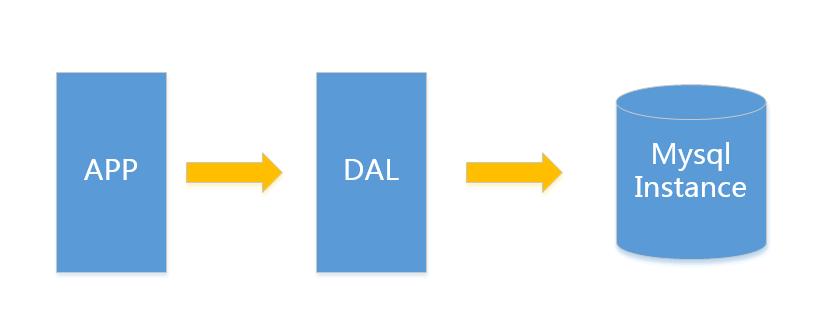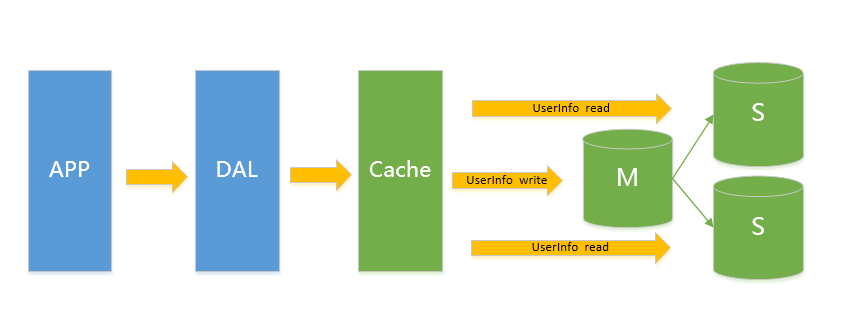The evolution of mysql application architecture in large websites
This article mainly describes the evolution of Mysql architecture under different concurrent access levels of the website
Scalability
The scalability of the architecture is often closely related to concurrency. Without the growth of concurrency, there is no need to be highly scalable. Based on the traditional architecture, here is a brief introduction to scalability. There are two commonly used expansion methods
Scale-up: Vertical expansion, by replacing with better machines and resources to achieve scaling and improve service capabilities
Scale -out: Horizontal expansion, by adding nodes (machines) to achieve scaling and improve service capabilities
For high-concurrency applications on the Internet, Scale out is undoubtedly the way out. Purchasing higher-end machines vertically has always been a taboo for us. The problem is not a long-term solution. Under the theory of scale out, what is the ideal state of scalability?
The ideal state of scalability
When a service faces higher concurrency, it can improve the concurrency supported by the service by simply adding machines, and the process of adding machines will have no impact on the online service (no down time) ), this is the ideal state of scalability!
Evolution of architecture
V1.0 Simple website architecture
The architecture behind a simple small website or application can be very simple. Only one mysql instance is needed for data storage to meet the data reading and writing needs (ignored here) Data backup instance), websites in this time period will generally store all information in a database instance.

Under this architecture, let’s take a look at what are the bottlenecks of data storage?
1. When the total size of the data cannot be accommodated in one machine
2. When the data index (B+ Tree) cannot be accommodated in the memory of one machine
3. The amount of access (mixed reading and writing) cannot be tolerated by one instance
Only when any one or more of the above three things are met, do we need to consider evolving to the next level. From this we can see that in fact, for many small companies and small applications, this architecture is enough to meet their needs. Accurate assessment of the initial data volume is an important step in preventing over-design. After all, no one wants to worry about the impossible. things and waste your experience.
Here is a simple example of mine. For tables like user information (3 indexes), 16G memory can hold an index of about 20 million rows of data. A simple mixed read and write access volume of about 3000/s is no problem. Your Is the application scenario
Vertical splitting of V2.0
Generally when V1.0 encounters a bottleneck, the first and easiest splitting method is vertical splitting. What is vertical? From a business perspective, data that is not strongly related is split into different instances to achieve the goal of eliminating bottlenecks. Taking the example in the figure, user information data and business data are split into three different instances. For scenarios where there are many repeated read types, we can also add a layer of cache to reduce the pressure on the DB.

Under this architecture, let’s take a look at what are the bottlenecks of data storage?
1. Single instance single business still has bottlenecks described in V1.0
When encountering bottlenecks, you can consider upgrading to a higher V version of this article. If read requests cause performance bottlenecks, you can consider upgrading to V3.0. Other bottlenecks should be considered Upgrade to V4.0
V3.0 Master-slave architecture
This type of architecture mainly solves the reading problem under the V2.0 architecture. It migrates the reading pressure by attaching real-time data backup to the Instance. In the Mysql scenario, it is through the master-slave structure. The master library resists write pressure and shares the read pressure through the slave library. For applications that write less and read more, the V3.0 master-slave architecture is fully capable

Under such an architecture, let’s take a look at the bottlenecks of data storage What is it?
1. The main library cannot bear the amount of writing
V4.0 Horizontal Split
When the V2.0 V3.0 solution encounters bottlenecks, it can be solved by horizontal splitting, horizontal splitting and vertical splitting There is a big difference. The result of vertical splitting is that one instance has the full amount of data, but after horizontal splitting, any instance only has 1/n of the full amount of data. The following figure shows the splitting of Userinfo as an example. Split the userinfo into 3 clusters. Each cluster holds 1/3 of the total data. The sum of the 3 cluster data is equal to a complete data (note: it is no longer called a single instance but a cluster to represent the main data). From a small mysql cluster)

How is the data routed?
1.Range split
Sharding key is routed according to continuous interval segments. It is generally used in scenarios with strict auto-increment ID requirements, such as Userid, a small example of Userid Range: Split using userid 3000W as Range No. 1 cluster userid 1-3000W Cluster No. 2 userid 3001W-6000W
2.List splitting
List splitting has the same idea as Range splitting, both routing to different clusters by giving different sharding keys, but the specific methods are somewhat different , List is mainly used for situations where the sharding key is not a continuous sequence and falls into a cluster

Hot AI Tools

Undresser.AI Undress
AI-powered app for creating realistic nude photos

AI Clothes Remover
Online AI tool for removing clothes from photos.

Undress AI Tool
Undress images for free

Clothoff.io
AI clothes remover

AI Hentai Generator
Generate AI Hentai for free.

Hot Article

Hot Tools

Notepad++7.3.1
Easy-to-use and free code editor

SublimeText3 Chinese version
Chinese version, very easy to use

Zend Studio 13.0.1
Powerful PHP integrated development environment

Dreamweaver CS6
Visual web development tools

SublimeText3 Mac version
God-level code editing software (SublimeText3)

Hot Topics
 1385
1385
 52
52
 MySQL: Simple Concepts for Easy Learning
Apr 10, 2025 am 09:29 AM
MySQL: Simple Concepts for Easy Learning
Apr 10, 2025 am 09:29 AM
MySQL is an open source relational database management system. 1) Create database and tables: Use the CREATEDATABASE and CREATETABLE commands. 2) Basic operations: INSERT, UPDATE, DELETE and SELECT. 3) Advanced operations: JOIN, subquery and transaction processing. 4) Debugging skills: Check syntax, data type and permissions. 5) Optimization suggestions: Use indexes, avoid SELECT* and use transactions.
 How to open phpmyadmin
Apr 10, 2025 pm 10:51 PM
How to open phpmyadmin
Apr 10, 2025 pm 10:51 PM
You can open phpMyAdmin through the following steps: 1. Log in to the website control panel; 2. Find and click the phpMyAdmin icon; 3. Enter MySQL credentials; 4. Click "Login".
 MySQL: An Introduction to the World's Most Popular Database
Apr 12, 2025 am 12:18 AM
MySQL: An Introduction to the World's Most Popular Database
Apr 12, 2025 am 12:18 AM
MySQL is an open source relational database management system, mainly used to store and retrieve data quickly and reliably. Its working principle includes client requests, query resolution, execution of queries and return results. Examples of usage include creating tables, inserting and querying data, and advanced features such as JOIN operations. Common errors involve SQL syntax, data types, and permissions, and optimization suggestions include the use of indexes, optimized queries, and partitioning of tables.
 Why Use MySQL? Benefits and Advantages
Apr 12, 2025 am 12:17 AM
Why Use MySQL? Benefits and Advantages
Apr 12, 2025 am 12:17 AM
MySQL is chosen for its performance, reliability, ease of use, and community support. 1.MySQL provides efficient data storage and retrieval functions, supporting multiple data types and advanced query operations. 2. Adopt client-server architecture and multiple storage engines to support transaction and query optimization. 3. Easy to use, supports a variety of operating systems and programming languages. 4. Have strong community support and provide rich resources and solutions.
 How to use single threaded redis
Apr 10, 2025 pm 07:12 PM
How to use single threaded redis
Apr 10, 2025 pm 07:12 PM
Redis uses a single threaded architecture to provide high performance, simplicity, and consistency. It utilizes I/O multiplexing, event loops, non-blocking I/O, and shared memory to improve concurrency, but with limitations of concurrency limitations, single point of failure, and unsuitable for write-intensive workloads.
 MySQL and SQL: Essential Skills for Developers
Apr 10, 2025 am 09:30 AM
MySQL and SQL: Essential Skills for Developers
Apr 10, 2025 am 09:30 AM
MySQL and SQL are essential skills for developers. 1.MySQL is an open source relational database management system, and SQL is the standard language used to manage and operate databases. 2.MySQL supports multiple storage engines through efficient data storage and retrieval functions, and SQL completes complex data operations through simple statements. 3. Examples of usage include basic queries and advanced queries, such as filtering and sorting by condition. 4. Common errors include syntax errors and performance issues, which can be optimized by checking SQL statements and using EXPLAIN commands. 5. Performance optimization techniques include using indexes, avoiding full table scanning, optimizing JOIN operations and improving code readability.
 MySQL's Place: Databases and Programming
Apr 13, 2025 am 12:18 AM
MySQL's Place: Databases and Programming
Apr 13, 2025 am 12:18 AM
MySQL's position in databases and programming is very important. It is an open source relational database management system that is widely used in various application scenarios. 1) MySQL provides efficient data storage, organization and retrieval functions, supporting Web, mobile and enterprise-level systems. 2) It uses a client-server architecture, supports multiple storage engines and index optimization. 3) Basic usages include creating tables and inserting data, and advanced usages involve multi-table JOINs and complex queries. 4) Frequently asked questions such as SQL syntax errors and performance issues can be debugged through the EXPLAIN command and slow query log. 5) Performance optimization methods include rational use of indexes, optimized query and use of caches. Best practices include using transactions and PreparedStatemen
 How to build a SQL database
Apr 09, 2025 pm 04:24 PM
How to build a SQL database
Apr 09, 2025 pm 04:24 PM
Building an SQL database involves 10 steps: selecting DBMS; installing DBMS; creating a database; creating a table; inserting data; retrieving data; updating data; deleting data; managing users; backing up the database.




